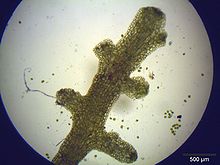Bayy Riccardimoos
| Bayy Riccardimoos | ||||||||||||
|---|---|---|---|---|---|---|---|---|---|---|---|---|

Riccardia chamedryfolia |
||||||||||||
| Systematics | ||||||||||||
|
||||||||||||
| Scientific name | ||||||||||||
| Riccardia chamedryfolia | ||||||||||||
| ( With. ) Grudge |
The Buchtige Riccardimoos ( Riccardia chamedryfolia ) is an autocratic ( antheridia and archegonia on different branches on the same plant), thallous liverwort .
Identifying features
The creeping to slightly ascending thalli of Riccardia chamedryfolia are dark to olive green in color. They are often pale green at the tips. The irregularly shaped thalli are also 1 to 3-fold pinnate with sometimes longer, sometimes wider, tongue-shaped thallus branches that can be up to 4 mm long and up to 1.5 mm wide. In the middle part they are about 4 to 8 cell layers thick. The underside is usually relatively flat, while the top is convex. In contrast to Riccardia multifida, the thallus margins are characterized by 0 to 1 row of hyaline cells. They therefore do not appear transparent when light shines through. The thallus tips are rounded. The epidermal cells are smaller than the cells inside and about 65 to 90 µm long and 25 to 50 µm wide. Almost all epidermal cells contain 1 to 3 brownish oil bodies . In addition to the short male branches, there are also shorter female branches that have cilia. The club-shaped kalyptra is papillary. There is a risk of confusion with Riccardia multifida , which is less common in northern Germany.
Occurrence
The low-competitive, pioneering liverwort grows on wet to moist, often trickled, alkaline, relatively poor in lime, shady to partially shaded locations at springs, river banks, trickled boulders, on tree roots and tree bases, on earth, sand and humus, in alkaline bogs and in peat cuttings. It also rarely grows submerged at the edges of water. Often it occurs as initial moss in disturbed places and is quickly overgrown by other mosses. The species has declined over the past few decades due to the destruction of springy sites, the straightening of rivers, water pollution and intensive agriculture. In some federal states the liverwort is on the red list.
literature
- Nebel, Philippi: Die Moose Baden-Württemberg Volume 3 . (Ulmer Verlag, 1st edition, 2005, ISBN 3-8001-3278-8 )
- Jan-Peter Frahm , Wolfgang Frey , J. Döring: Moosflora . 4th edition (UTB Verlag), ISBN 3-8252-1250-5

